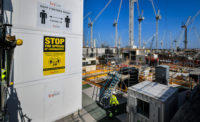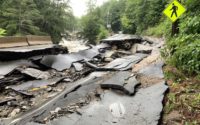Even while survivors struggle through the grim process of removing bodies and debris left by the 7.0 magnitude earthquake that rocked Haiti on Jan. 12, relief organizations are mustering materials and skills to help Haitians rebuild their lives and economy.

The World Economic Forum’s Disaster Relief Network is one group mobilizing aid to work on hospitals and orphanages in the villages of Duverger and Dandann, about 80 miles north of Port-au-Prince, says Nicol�s Mariscal, president and chairman of Grupo Marhnos, Mexico City, a commercial construction firm and a DRN member company.
Grupo Marhnos is coordinating DRN’s response, says Alex Wong, senior director head for the forum’s Center for Global Industries. Within a week of the disaster, Hindustan Construction Company Ltd., Alwarpet Chennai, India had partnered with Grupo Marhnos and was assembling a team of engineering-in-emergencies trained engineers to deploy, says Sandra de Garay, a spokeswoman in corporate social responsibility and institutional relations at Grupo Marhnos.
“We know there are around 800,000 children who are homeless,” Mariscal says. “We have to be concentrated in something very specific, and we believe these hospitals serving children are very worthwhile.”
In a related initiative, the Mexican firm also is transporting to Haiti, through the Dominican Republic, a self-sustaining, prefabricated classroom accompanied by a technician/instructor to teach women, children and other non-specialized personnel to assemble the classroom and aid in their own recovery, de Garay says. Assembly should take no more than three days, says de Garay.
A third company is involved: Grupo Metal Intra S.A. de C.V., San Juan Del Rio, Mexico. It describes itself as a metal transformation company that designs, manufactures and supplies modern construction building systems for the home, education and hospital markets, including prefabricated classrooms as well as dwellings and other buildings constructed with structural PET panels. The panels are made from post-consumer recycled Polyethylene Terephthalate—plastic bottle flakes. The PET boards are used for walls, roofing, doors, insulation material, as well as for closets and internal partitions.
Oscar Peralta Navarrete, GMI group president, says the classroom units are designed to resist earthquakes and hurricane force winds.
Grupo Metal Intra plans to install the classroom as a demonstration and then use its anticipated success to gain approval and financing to build a PET panel manufacturing plant in Haiti, which it says could be accomplished in about 8 months. In the meantime the panels can be shipped in from a plant in Europe.
The DRN is working with Unidos por Ellos (United for Them), a public private partnership which coordinates efforts among civil society, non-profit institutions, private companies, mass media, financial sector and academia, says de Garay.
The main objectives of the PPP for humanitarian assistance are: relief, recovery, reconstruction and/or relocation of the affected communities. “The earthquake in Haiti provides DRN an opportunity to be doers and not just donors,” de Garay says. The PPP is also organizing fundraising that matches every personal donation, dollar for dollar, peso for peso, with company funds and then matches again with local bank contributions.
Grupo Marhnos has worked on other disasters in Mexico and anticipates no shortage of engineering/construction firms willing to contribute pro bono work to help Haiti, Mariscal says. “We have no idea yet about the number of people or dollar amount we will contribute.” The DNR will likely target participation by Haitian companies and workers to assist with the recovery.
The DRN includes participation by logistics experts who specialize in preventing and unstopping bottlenecks in disaster areas. Partner and member companies include: Amec, United Kingdom; CH2M Hill Companies, U.S.A; Fluor Corporation, USA; Siemens, Germany; Skanska, Sweden; and others.
Haiti will also be on the agenda at the World Economic Forum’s annual meeting Jan. 27-31 in Davos-Klosters, Switzerland. The theme of this year’s meeting is: Improve the State of the World: Rethink, Redesign, Rebuild.



Post a comment to this article
Report Abusive Comment